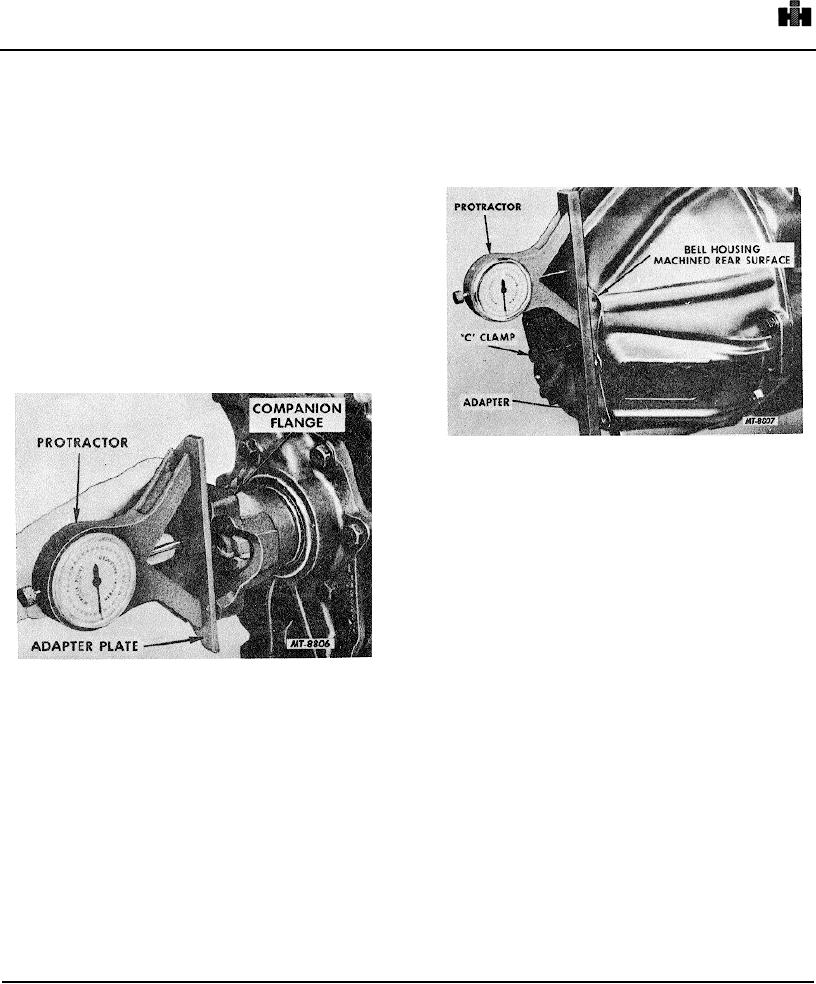
PROPELLER SHAFT
TRUCK SERVICE MANUAL
General
Place an SE-2067 magnetic base protractor on the
When aluminum bell housings are encountered, the
horizontally machined surface of the cylinder head,
protractor will not adhere; therefore, it will be necessary
crankcase oil pan rail or possibly along the flange of the
to either hold protractor firmly or clamp a steel straight
rocker arm cover, Fig. 11. This angle establishes the
edge in a vertical position and place the protractor on the
correct vertical angle for all propeller shaft flanges and
straight edge, Fig. 13. The protractor dial should read 90
yokes.
degrees minus the number of degrees of engine
Read and record the number of degrees of engine
declination.
declination indicated on the protractor dial. This is the
engine angle.
Place transmission shift lever in neutral position.
Rotate transmission mainshaft to place flange C in a
vertical position. Place SE2067 magnetic base
protractor in a vertical position with one leg of protractor
base on flange machined surface as shown in Fig. 12.
Protractor reading should be 90 degrees minus the
number of degrees of engine declination. If readings
differ by more than 1/2 degree, the flange is misaligned
in the vertical plane. In other words, the flange machined
surface is not perpendicular (90) to the engine
crankshaft center line.
Fig. 13. Checking Bell Housing Vertical Alignment Using
SE-2067 Magnetic Base Protractor
If misalignment still exists, it will be necessary to
remove the bell housing and check the vertical alignment
of the flywheel housing (if applicable) using same
checking method as used with bell housing check.
Some engine models require a flywheel housing to
be used between the engine rear machined face and the
bell housing. If previous checks have not eliminated the
vertical misalignment, remove the bell housing and
clutch assembly. The rear machined face of the flywheel
housing can be checked using a straight edge and
Fig. 12. Checking Main Transmission Companion
SE2067 protractor held firmly in a vertical position. The
Flange Vertical Alignment
reading should be 90 degrees minus the number of
degrees of engine declination. In other words, this
If the companion flange run-out is within limitations
surface must be perpendicular (90 degrees) to the
but the vertical alignment is not, it indicates that the
engine crankshaft horizontal center line. Misalignment of
problem lies within the mating surfaces of the flywheel
less than 1/2 degree at this point would indicate that the
housing to engine, bell housing to flywheel housing or
problem lies with the front and rear machined surfaces of
transmission housing to bell housing. Misalignment of
the flywheel housing and bell housing not being parallel
any of these components is highly improbable, since the
or that the front machined surface of the transmission is
mating surfaces are machined to strict tolerances;
not perpendicular to the mainshaft. These conditions
however, since the possibility does exist, it will be dealt
can be readily checked. It should be noted, however,
with herein.
that foreign material such as a piece of an old gasket not
To determine which component is at fault, remove
removed during a previous service operation will result in
the transmission and check the bell housing rear
misalignment of the transmission flange in either a
machined face for vertical alignment. Clean the face of
vertical or horizontal plane, depending upon its location.
all foreign material and place SE-2067 magnetic base
protractor in a vertical position on this face. NOTE:
598

